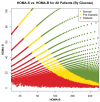Lifestyle Modification in Prediabetes and Diabetes: A Large Population Analysis
- PMID: 40284198
- PMCID: PMC12030603
- DOI: 10.3390/nu17081333
Lifestyle Modification in Prediabetes and Diabetes: A Large Population Analysis
Abstract
Background/Aims: Diabetes mellitus is a major cause of atherosclerotic cardiovascular disease (ASCVD). We examined a large population and tested the efficacy of a voluntary lifestyle program in prediabetic and diabetic subjects. Methods: Of 133,764 subjects, 56.3% were healthy, 36.2% were prediabetic, and 7.5% were diabetic. Fasting serum measurements of glucose, insulin, adiponectin, glycosylated hemoglobin (HbA1c), high-sensitivity C-reactive protein (hs-CRP), glycated serum protein (GSP), fibrinogen, myeloperoxidase (MPO), lipoprotein-associated phospholipase A2 (LpPLA2), as well as standard lipids, direct low-density lipoprotein cholesterol (LDL-C), and small dense LDL-C (sdLDL-C) were performed using standard automated assays. Follow-up sampling at 6-12 months occurred in 20.1% of the prediabetic and 22.2% of the diabetic subjects; of these, 12.2% of the prediabetic and 9.7% of the diabetic subjects participated in a voluntary, real-world, digital dietitian-directed lifestyle-modification program with a 10-year diabetes risk being calculated using a biochemical model (Framingham). Results: Prediabetic and diabetic subjects had significantly elevated triglycerides, sdLDL-C, and hs-CRP and decreased HDL-C. They were insulin resistant as compared to healthy subjects, but only diabetics had significant reductions in insulin production. Lifestyle modification significantly reduced diabetes risk by 45.6% in prediabetics and significantly increased (2.4-fold) the percentage of diabetics that were in remission at follow-up (8.2% versus 3.4%) with increased weight loss (6.5 versus 2.0 pounds). Lifestyle intervention resulted in significant favorable effects on many metabolic markers. Conclusions: The measurement of fasting glucose and insulin is essential for the detection of decreased insulin production in diabetics. A digital lifestyle program can have favorable effects on ASCVD risk factors and diabetic status.
Keywords: ASCVD risk; HOMAIR; diabetes; fasting glucose; insulin; lifestyle; prediabetes.
Conflict of interest statement
M.R.D. is an employee of Boston Heart Diagnostics, Framingham, MA, USA. All other authors are former employees of Boston Heart Diagnostics but have no competing interests to declare.
Figures

Similar articles
-
Lipoprotein Subfractions and Glucose Homeostasis in Prediabetes and Diabetes in Taiwan.J Atheroscler Thromb. 2019 Oct 1;26(10):890-914. doi: 10.5551/jat.48330. Epub 2019 Feb 7. J Atheroscler Thromb. 2019. PMID: 30726792 Free PMC article.
-
The effects of supervised aerobic training on dyslipidaemia among diabetic older patients.BMC Endocr Disord. 2024 Oct 9;24(1):212. doi: 10.1186/s12902-024-01745-8. BMC Endocr Disord. 2024. PMID: 39385223 Free PMC article.
-
Diabetes Mellitus Risk Prediction in the Framingham Offspring Study and Large Population Analysis.Nutrients. 2025 Mar 24;17(7):1117. doi: 10.3390/nu17071117. Nutrients. 2025. PMID: 40218874 Free PMC article.
-
Behavior Modification in Prediabetes and Diabetes: Potential Use of Real-Time Continuous Glucose Monitoring.J Diabetes Sci Technol. 2019 Mar;13(2):271-275. doi: 10.1177/1932296818790994. Epub 2018 Aug 1. J Diabetes Sci Technol. 2019. PMID: 30066574 Free PMC article. Review.
-
Effectiveness of Dietitian-Involved Lifestyle Interventions in Diabetes Management Among Arab Populations: A Systematic Review and Meta-Analysis.Nutrients. 2024 Dec 11;16(24):4283. doi: 10.3390/nu16244283. Nutrients. 2024. PMID: 39770905 Free PMC article.
References
-
- Centers for Disease Control and Prevention Fact Sheet on Diabetes and Prediabetes. [(accessed on 12 January 2025)]; Available online: https://www.cdc.gov/diabetes/index.html.
-
- Steven S., Hollingsworth K.G., Al-Mrabeh A., Avery L., Aribisala B., Caslake M., Taylor R. Very Low-Calorie Diet and 6 Months of Weight Stability in Type 2 Diabetes: Pathophysiological Changes in Responders and Nonresponders. Diabetes Care. 2016;39:808–815. doi: 10.2337/dc15-1942. Erratum in Diabetes Care 2018, 41, 1321. - DOI - PubMed
MeSH terms
Substances
Grants and funding
LinkOut - more resources
Full Text Sources
Medical
Research Materials
Miscellaneous

